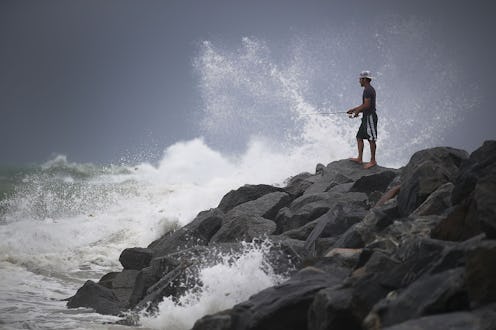
With monstrous Hurricane Irma expected to make landfall overnight in Florida, Gov. Rick Scott has been warning residents about dangerous storm surges as a result of Irma. "The threat of significant storm surge flooding along the entire west coast of Florida has increased," Scott said in a Saturday morning news conference, CNN reported. Depending on where Floridians are located, the storm surge could be between 10 and 15 feet. "This will cover your house."
Florida's east coast, which had been the hurricane's primary target for days, is now expected to be spared the worst, but a 2-4 foot storm surge is still likely for residents on Florida's Atlantic coast. A graphic on Twitter from ABC News Chief Meteorologist Ginger Zee shows storm surges for those along Florida's west coast as being anywhere from 10-15 feet in southwest Florida, 5-10 feet near Tampa, and 3-6 feet near the panhandle.
The National Hurricane Center has an interactive graphic that shows predicted storm surges for areas in Irma's path, with locales along Florida's southwest coast in danger of experiencing surges more than 9 feet. Additionally, the NHC noted that storm surges can be the most deadly part of a hurricane because a relatively small amount of water can cause massive damage and loss of life.
"A mere six inches of fast-moving flood water can knock over an adult," the NHS noted. "It takes only two feet of rushing water to carry away most vehicles — including pickups and SUVs... During the peak of a storm surge event, it is unlikely that emergency responders will be able to reach you if you are in danger."
The mass destruction and loss of life during and after Hurricane Katrina was the result of a storm surge. "In fact, it can be the most dangerous part of any hurricane, and it is only partly determined by wind speed (the aspect of a storm on which the hurricane categories are based)," Vox reported. "It occurs when strong winds from an approaching hurricane push water into the shore."
What's more, the Chicago Tribune reported that hurricane center storm surge specialist Jamie Rhome said that storm surge, and not rain and wind, is the primary reason residents are asked to evacuate ahead of a hurricane. "People don't understand the water," Rhome said in the Tribune. "You're not going to get out and swim away. It's got waves on it, it's got debris in it."
The storm surge is likely to start before Irma makes landfall. Federal Emergency Management Agency chief Brock Long said Friday that Irma will have a devastating impact on the state, the Tribune noted.
In attempt to drive home the calamity storm surges can cause, AccuWeather compared storm surges of other U.S. hurricanes:
- Hurricane Ike, 2008: Ike, a category 2 hurricane, resulted in surges between 15 and 20 feet above normal tide levels along the Bolivar Peninsula of Texas and in the Galveston Bay area.
- Hurricane Katrina, 2005: Known as one of the most devastating hurricanes in recent history, Katrina caused surge flooding that soared up to 28 feet above normal tide level.
- Hurricane Dennis, 2005: Hurricane Dennis struck much of Florida and stretched to inland portions of the southeastern U.S. Storm surge flooding was between 7-9 feet, and caused severe damage.
- Hurricane Isabel, 2003: Isabel made a name for itself as one of the worst hurricanes in recent years. Storm surges reaching 8 feet over normal tide levels spread into Virginia Maryland, Delaware, and Washington D.C.
The comparisons make an important point — destructive storm surges can come from even low level hurricanes like the category 2 Ike, and category 3 Katrina. In fact, the NHS explained that there is no correlation between hurricane level and the possibility of storm surges.
"Tropical storms, category 1 or 2 hurricanes, major (category 3 to 5) hurricanes, and post-tropical cyclones can all cause life-threatening storm surge."
Currently, ABC News meteorologists have forecasted storm surges of 10 feet in Tampa and Sarasota, and 10 to 15 feet from Fort Myers to Naples. Lower storm surges of 3 to 6 feet may occur from Miami to Key Largo. Despite being lower, these storm surges are still extremely dangerous.